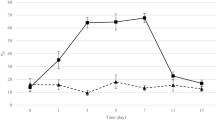Summary
We have investigated which dose of amphotericin B can be regarded as an optimal oral dose for the prophylaxis of colonization of the digestive tract byCandida species. Ten human volunteers were given different doses; each dose was administered for five days. The results of this study revealed that although oral doses of 0.5 g amphotericin B per day resulted in sufficient concentrations in 70% of the faecal samples obtained during application, higher doses (1.5 or 2 g per day) were required to obtain detectable amphotericin B activity in 95% and 100% of the samples, respectively. A daily dose of 1.0 g is recommended. We have taken into consideration the variation in amphotericin B concentrations among individuals following this recommended dose.
Zusammenfassung
In der vorliegenden Arbeit wurden Untersuchungen zur optimalen Dosierung von Amphotericin B bei oraler prophylaktischer Verabreichung zum Schutz vor Besiedelung des Verdauungstraktes mitCandida Spezies vorgenommen. Zehn freiwillige Probanden erhielten verschiedene Dosen, von denen jede fünf Tage lang verabreicht wurde. Die Ergebnisse der Studie zeigten, daß zwar mit einer täglichen oralen Dosis von 0,5 g Amphotericin B in 70% der während der Applikation gewonnenen Stuhlproben ausreichend hohe Konzentrationen der Substanz vorlagen, doch wurden erst mit Dosen von 1,5 g oder 2 g Amphotericin B pro Tag in 95% bzw. 100% der Proben meßbare Konzentrationen erzielt. Unter Berücksichtigung der interindividuellen Schwankungen der Amphotericin-B-Konzentrationen wird eine Dosis von 1,0 g pro die empfohlen.
Similar content being viewed by others
Literature
Krick, J. A., Remington, J. S. Opportunistic invasive fungal infections in patients with leukemia and lymphoma. Clin. Haematol. 5 (1976) 249–310.
Waaij, D. van der, Tielemans-Speltie, T. M., de Roeck-Houben, A. M. J. Infection by and distribution of biotypes ofEnterobacteriaceae species in leukaemic patients treated under ward conditions and in units for protective isolation in seven hospitals in Europe. Infection 3 (1977) 188–194.
Schimpff, S. C., Young, V. M., Greene, W. H., Vermeulen, G. D., Moody, M. R., Wiernik, P. H. Origin of infection in acute nonlymphocytic leukemia. Significance of hospital acquisition of potential pathogens. Ann. Int. Med. 77 (1972) 707–714.
Bender, J. F., Schimpff, S. C., Young, V. M., Fortner, C. L., Love, L. J., Brouillet, M. D., Wiernik, P. H. A comparative trial of tobramycin vs gentamicin in combination with vancomycin and nystatin for alimentary tract suppression in leukemic patients. Eur. J. Cancer 15 (1979) 34–44.
Bodes, G. P., Rodriguez, V. Infections in cancer patients on a protected environment-prophylactic antibiotic program. Am. J. Med. 59 (1975) 497–504.
Schimpff, S. C., Greene, W. H., Young, V. M., Fortner, C. L., Jepsen, L., Cusack, N., Block, J. B., Wiernik, P. H. Infection prevention in acute non-lymphocytic leukemia. Laminar air flow room reverse isolation with oral, nonabsorbable antibiotic prophylaxis. Ann. Int. Med. 82 (1975) 351–358.
Guiot, H. F. L., Furth, R. van Partial antibiotic decontamination. Br. Med. J. 1 (1977) 800–802.
Sleijfer, D. T., Mulder, N. H., Vries-Hospers, H. G. de, Fidler, V., Nieweg, H. O., Waaij, D. van der, Saene, H. K. F. van Infection prevention in granulocytopenic patients by selective decontamination of the digestive tract. Eur. J. Cancer 16 (1980) 859–869.
Walter, A. H., Heilmeyer, L. Antibiotika-Fibel. Antibiotika- und Chemotherapeutika-Therapie mikrobieller Infektionen, 4th ed., Georg Thieme Verlag, Stuttgart 1975, pp. 666–672.
Hofstra, W., Vries-Hospers, H. G. de, Waaij, D. van der Concentrations of nystatin in faeces after oral administration of various doses. Infection 4 (1979) 166–170.
Goss, W. A., Cimijotti. B.: Evaluation of an automatic diluting device for microbiological application. Appl. Microbiol. (1968) 1414–1416.
Louria, D. B. Some aspects of the absorption, distribution and excretion of amphotericin B in man. Antibiot. Med. Clin. Ther. 5 (1957) 295–301.
Author information
Authors and Affiliations
Rights and permissions
About this article
Cite this article
Hofstra, W., de Vries-Hospers, H.G. & van der Waaij, D. Concentrations of amphotericin B in faeces and blood of healthy volunteers after the oral administration of various doses. Infection 10, 223–227 (1982). https://doi.org/10.1007/BF01666915
Received:
Issue Date:
DOI: https://doi.org/10.1007/BF01666915



